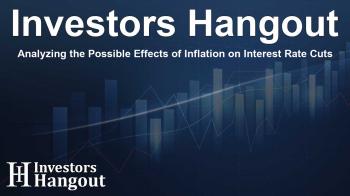Analyzing the Possible Effects of Inflation on Interest Rate Cuts

Understanding the Impact of Inflation on Rate Cuts
As we navigate the economic landscape, many are looking toward the future of interest rates and what the Federal Reserve will decide in upcoming meetings. Currently, there is a strong market belief that the Fed will implement a cut in interest rates in the near future. However, the looming question is whether inflation data will play a decisive role in this decision-making process.
The Role of Inflation in Monetary Policy
Expectations suggest that the central bank may ease its policies soon, largely driven by market predictions and economic indicators. One of the key indicators is the performance of the US 2-year yield, which typically reflects the market's expectations regarding interest rates. Presently, the yield is at 3.72%, significantly lower than the median Fed funds rate of 4.33%. This discrepancy indicates that investors are anticipating possible policy adjustments by the central bank.
Analyzing Key Economic Indicators
To further understand these trends, analysts look at models comparing the median Fed funds target rate with other economic indicators, such as the unemployment rate and the annual change in headline consumer inflation. This analysis reflects how the Fed is striving to balance its dual mandate of controlling inflation while fostering maximum employment. Current assessments show that monetary policy remains somewhat tight, suggesting a pathway for potential easing.
The Market's Expectations
Fed funds futures have signaled a high probability—approximately 87%—for a cut in rates next month. Yet, a significant concern remains regarding tariff-related inflation and how it may influence the upcoming consumer price index data set for release before the Fed's next policy announcement.
Tariffs and Their Economic Implications
Many economists are signaling that tariffs could lead to a temporary rise in inflation levels. Recent consumer inflation reports show a year-over-year increase, hitting 2.7%, which is above the Fed's target inflation rate of 2%. This trend further raises questions about the sustainability of inflationary trends and the Fed's response.
Expert Insights on Inflation Trends
Beth Hammack, the president and CEO of the Federal Reserve Bank of Cleveland, noted that businesses may begin to transfer the costs associated with tariffs to consumers, which could drive inflation higher. As stockpiles diminish, companies will be compelled to adjust prices, which may have further implications for consumer demand.
Economists Weigh In
Greg Daco, chief economist at EY-Parthenon, echoed these sentiments, emphasizing that the effects of tariffs are becoming apparent and may lead to increased inflationary pressures. Such pressures could potentially dampen consumer spending and make businesses more cautious in their operational decisions.
Investor Sentiment Ahead of Data Releases
The debate over whether inflation poses a real threat continues as investors await the upcoming CPI data. This information will be crucial as it may sway sentiment and provide insight into how aggressive the Fed should be regarding interest rate adjustments.
The Fed's Position
As September approaches, the Fed faces mounting pressure to clarify its stance on these economic challenges, particularly concerning tariff-induced inflation. San Francisco Fed President Mary Daly expressed this sentiment, indicating that the Fed must remain vigilant and possibly reconsider its strategy if inflation data suggests a persistent upward trend.
Looking Towards the Future
In a climate of uncertainty, the Fed must navigate its path carefully. With healing from previous economic disruptions still ongoing, market players are keenly watching these indicators. Ultimately, the intersection of inflation data and monetary policy decisions will be pivotal in shaping economic expectations in the months to come.
Frequently Asked Questions
What indicators are influencing the Fed's interest rate decisions?
Key indicators include the US 2-year yield, unemployment rates, and consumer inflation changes, all of which reflect economic sentiment.
How might tariffs affect consumer inflation?
Higher tariffs can lead to increased costs for businesses, which may be passed on to consumers, potentially elevating inflation rates.
What probability does the market assign to a rate cut next month?
The market is currently pricing in an 87% chance that the Fed will cut interest rates in the upcoming meeting.
Why is the upcoming CPI data significant?
The CPI data will provide crucial insights into inflation trends and may influence the Fed's decision on interest rates.
How is the Federal Reserve addressing potential inflation threats?
The Fed is closely monitoring economic indicators and may adjust its policies in response to changes in inflation and labor market conditions.
About The Author
Contact Evelyn Baker privately here. Or send an email with ATTN: Evelyn Baker as the subject to contact@investorshangout.com.
About Investors Hangout
Investors Hangout is a leading online stock forum for financial discussion and learning, offering a wide range of free tools and resources. It draws in traders of all levels, who exchange market knowledge, investigate trading tactics, and keep an eye on industry developments in real time. Featuring financial articles, stock message boards, quotes, charts, company profiles, and live news updates. Through cooperative learning and a wealth of informational resources, it helps users from novices creating their first portfolios to experts honing their techniques. Join Investors Hangout today: https://investorshangout.com/
The content of this article is based on factual, publicly available information and does not represent legal, financial, or investment advice. Investors Hangout does not offer financial advice, and the author is not a licensed financial advisor. Consult a qualified advisor before making any financial or investment decisions based on this article. This article should not be considered advice to purchase, sell, or hold any securities or other investments. If any of the material provided here is inaccurate, please contact us for corrections.

